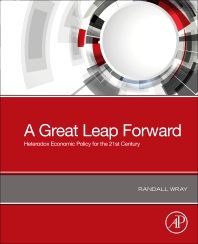
Research Topics
Publications on Heterodox macroeconomics
-
A Great Leap Forward
Book Series, January 2020 | January 2020Heterodox Economic Policy for the 21st Century
 A Great Leap Forward: Heterodox Economic Policy for the 21st Century investigates economic policy from a heterodox and progressive perspective. Author Randall Wray uses relatively short chapters arranged around several macroeconomic policy themes to present an integrated survey of progressive policy on topics of interest today that are likely to remain topics of interest for many years.
A Great Leap Forward: Heterodox Economic Policy for the 21st Century investigates economic policy from a heterodox and progressive perspective. Author Randall Wray uses relatively short chapters arranged around several macroeconomic policy themes to present an integrated survey of progressive policy on topics of interest today that are likely to remain topics of interest for many years.
Published by: Elsevier Press -
The Dismal State of Macroeconomics and the Opportunity for a New Beginning
Working Paper No. 652 | March 2011The Queen of England famously asked her economic advisers why none of them had seen “it” (the global financial crisis) coming. Obviously, the answer is complex, but it must include reference to the evolution of macroeconomic theory over the postwar period—from the “Age of Keynes,” through the Friedmanian era and the return of Neoclassical economics in a particularly extreme form, and, finally, on to the New Monetary Consensus, with a new version of fine-tuning. The story cannot leave out the parallel developments in finance theory—with its efficient markets hypothesis—and in approaches to regulation and supervision of financial institutions.
This paper critically examines these developments and returns to the earlier Keynesian tradition to see what was left out of postwar macro. For example, the synthesis version of Keynes never incorporated true uncertainty or “unknowledge,” and thus deviated substantially from Keynes’s treatment of expectations in chapters 12 and 17 of the General Theory. It essentially reduced Keynes to sticky wages and prices, with nonneutral money only in the case of fooling. The stagflation of the 1970s ended the great debate between “Keynesians” and “Monetarists” in favor of Milton Friedman’s rules, and set the stage for the rise of a succession of increasingly silly theories rooted in pre-Keynesian thought. As Lord Robert Skidelsky (Keynes’s biographer) argues, “Rarely in history can such powerful minds have devoted themselves to such strange ideas.” By returning to Keynes, this paper attempts to provide a new direction forward.
Download:Associated Program:Author(s): -
Money
Working Paper No. 647 | December 2010This paper advances three fundamental propositions regarding money:
(1) As R. W. Clower (1965) famously put it, money buys goods and goods buy money, but goods do not buy goods.
(2) Money is always debt; it cannot be a commodity from the first proposition because, if it were, that would mean that a particular good is buying goods.
(3) Default on debt is possible.
These three propositions are used to build a theory of money that is linked to common themes in the heterodox literature on money. The approach taken here is integrated with Hyman Minsky’s (1986) work (which relies heavily on the work of his dissertation adviser, Joseph Schumpeter [1934]); the endogenous money approach of Basil Moore; the French-Italian circuit approach; Paul Davidson’s (1978) interpretation of John Maynard Keynes, which relies on uncertainty; Wynne Godley’s approach, which relies on accounting identities; the “K” distribution theory of Keynes, Michal Kalecki, Nicholas Kaldor, and Kenneth Boulding; the sociological approach of Ingham; and the chartalist, or state money, approach (A. M. Innes, G. F. Knapp, and Charles Goodhart). Hence, this paper takes a somewhat different route to develop the more typical heterodox conclusions about money.
Download:Associated Program:Author(s): -
Revisiting “New Cambridge”: The Three Financial Balances in a General Stock-flow Consistent Applied Modeling Strategy
Working Paper No. 594 | May 2010This paper argues that modified versions of the so-called “New Cambridge” approach to macroeconomic modeling are both quite useful for modeling real capitalist economies in historical time and perfectly compatible with the “vision” underlying modern Post-Keynesian stock-flow consistent macroeconomic models. As such, New Cambridge–type models appear to us as an important contribution to the tool kit available to applied macroeconomists in general, and to heterodox applied macroeconomists in particular.
